|
Tomato Preparation | Tomato Cooking | Tips | Tomato Garnish
| Tomatoes |
|

In the plant family, the tomato is classified as a fruit (berry), but when eaten it resembles a vegetable. Raw or cooked tomatoes have a sweet, acidic flavor and a juicy flesh. Available in different sizes, shapes and colors, tomatoes can be large and round like, oval shaped as are Roma or plum tomatoes, pear shaped like pear tomatoes, or small and bite size, such as cherry and grape tomatoes. Tomatoes are available in a range of colors, such as green, yellow, red, and purple. |
|
Uses:
They are often eaten raw as a garnish for salads and appetizers, sliced thinly for sandwiches, or added to various pasta, meat, and vegetable dishes. They are also used in soups, stews, and sauces. |
| At Their Best:
Fresh tomatoes are available throughout the year but most abundant at the end of the summer. They are best when freshly picked off the vine. Since fresh tomatoes are very perishable, supermarkets purchase tomatoes that have been picked when green and then forced to ripen. These tomatoes will keep longer in the supermarkets but will never have the taste and texture of a vine ripened tomato. Some markets carry vine ripened tomatoes, but at a much higher price. Home grown, vine ripened tomatoes can also be found at many farmers markets later in the summer and into fall. |
|
How to Buy: When selecting tomatoes, choose those that are brightly colored, plump, heavy and whose skins are not shriveled. Avoid those with blemishes, bruises, or cracks. Ripe tomatoes should yield to light pressure, but not be too soft. If purchasing tomatoes that will not be used for a few days, select those that are a lighter red and allow them to ripen fully by storing them in a cool area out of the direct sunlight. Canned tomatoes that have been processed are available in a variety of flavors and forms. They can be purchased in the can as whole, diced, stewed, chopped, pureed, paste, or a sauce form. |
|
Storage:
Do not store ripe tomatoes in the refrigerator because this will cause them to become pulpy and lose their flavor. Store at room temperature and out of the sunlight. Ripe tomatoes should be used within a few days. |
| Varieties: |
|
Plum Tomato
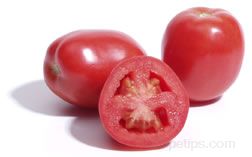 |
An oval, egg-shaped tomato with good flavor and thick flesh, which makes it a good tomato for sauces, cooking and canning. Since it has a lower water content, it produces a thick and flavorful sauce. It is approximately 3 inches long, an inch or two in diameter and is available as a red or yellow tomato. This tomato is also known as the Italian, Roma, paste, sauce, or saladette tomato. Plum tomatoes are grown in the United States and Mexico and are readily available. |
|
Cherry Tomato
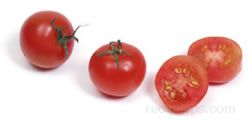
|
A variety of tomato that is usually an inch or less in diameter, has a bright red or yellow color, and a sweet tomato flavor. However, the yellow variety is not as flavorful as the red variety. Cherry tomatoes are eaten raw as a snack, served as a popular addition to salads, placed as a garnish for other foods, and served sautéed or cooked lightly for a side dish. |
Grape Tomato
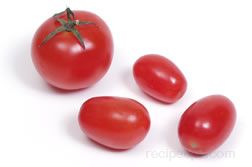 |
A variety of tomato that is small and round and most often used whole in salads or as a snack food and appetizer. It is generally available as either red or yellow in color and slightly smaller than a cherry or pear tomato, ranging in size from one half to almost an inch in diameter. It is closer in size to the currant tomato. |
Pear Tomato
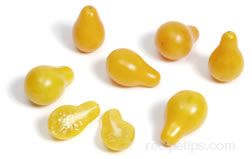 |
A variety of the tomato that is similar in texture to cherry tomatoes but milder in flavor and smaller in size with a shape like a pear. It is available in several colors, which include red, yellow or orange, and is also known as the teardrop tomato. They are served whole in salads or as appetizers and snacks. |
|
Sun-Dried Tomato
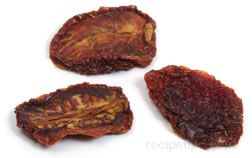
|
A tomato that has been sliced or cut in half and then dried in the sun (or in an oven). Drying the tomato gives it an intense, sweet flavor, that may also be somewhat tart, and a very chewy texture if completely dried and not marinated in oil. They are available fully dried without oil or dried and then softened and flavored by packing them in olive oil. Prior to being eaten, the fully dried variety can be soaked in water to rehydrate the tomato. Sun-dried tomatoes can be eaten raw as a snack or added to salads and other dishes. They are used to flavor pasta, vegetable dishes, appetizers, sauces, dips, soups, and sandwiches. |
Tomato Preparation
Remove Skins | Remove Seeds | Stuffed Tomatoes | Dehydrate | Freeze
Before preparing tomatoes to eat, cook, or add to other dishes, gently wash them under cold running water. The tomatoes can be simply sliced and eaten on their own, added to sandwiches, or salads, or they can be prepared to be used in other dishes. When slicing tomatoes, it works best to use a knife with a serrated edge. Several preparation methods are shown below.
Remove Tomato Skins:
|
Wash tomatoes under cool running water.
Slice an "X" on the bottom of each tomato with a small utility knife. |
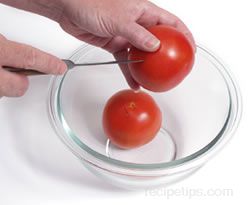 |
| In a large saucepan bring water to a rolling boil.
Fill a large mixing bowl with ice cold water.
With a large spoon, place tomatoes in boiling water for 30 seconds to loosen skin. |

|
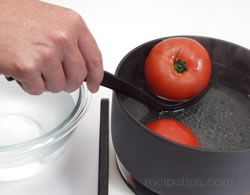 |
 |
| Remove tomatoes after 30 seconds, place directly into cold water to stop the cooking process. |
 |
 |
| Core the tomatoes by removing the stem with a paring knife. |
| Peel away the skin, being careful not to injure the flesh of the tomatoes. |
 |
Removing Seeds
Stuffed Tomato
|
Slice off the top of the tomato. With a small teaspoon (1/8 or 1/4 teaspoon), or small melon baller, scoop out the inside of the tomato. Fill with prepared stuffing or favorite dip. |
 |
How to Dehydrate Tomatoes
Dehydrating tomatoes is a process that slowly removes the moisture from tomatoes. This process preserves the tomatoes and allows them to be stored for a longer period of time. The dehydrating process can be done in a conventional oven or in a dehydrator. Use ripe meaty tomatoes when dehydrating.
Tomatoes can be dried with the skins removed or with the skins left on. To remove the skins, see the instructions above for Remove Tomato Skins. If leaving skins on, just remove the stem and core. Slice tomatoes into 1/2 inch slices. If drying cherry or plum tomatoes, cut in half lengthwise and make a slit in the middle of the skin side to help the dehydrating process.
|
|
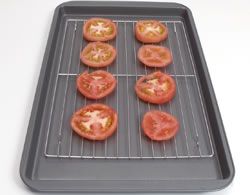 |
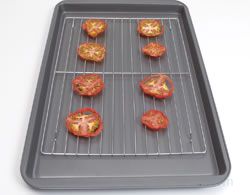 |
|
Place tomatoes on cooling racks in a baking pan to allow air to circulate around the tomatoes. Place halved cherry and plum tomatoes with the skin side down on the rack. Leave 1/2 to 1 inch of space between tomatoes. Season with salt and pepper if desired. Preheat oven to 120º-150º F. Place racks of tomatoes in oven and leave oven door slightly open to help moisture escape.
Drying will take anywhere from 10-18 hours, depending on air circulation. Rotate the the baking pans between the top and bottom rack through out the drying time to help the tomatoes dry evenly. Slices can also be turned over to the other side to help the tomatoes dry more evenly. |
|
|
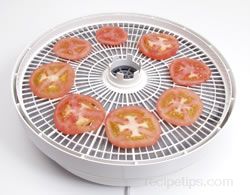 |
 |
|
Place tomatoes on the trays of the dehydrator. Place halved cherry and plum tomatoes with the skin side down on the rack. Leave 1/2 to 1 inch of space between tomatoes to allow for sufficient air circulation. If the dehydrating unit has several layers of trays, fill as many trays as necessary but be sure to leave 1 to 2 inches between the trays when they are stack. Season with salt and pepper if desired. If dehydrator has a thermostat, set it between 135° to 145°F.
Drying will take anywhere from 6-18 hours, depending on the number and thickness of tomatoes. Rotate the the trays from top to bottom through out the drying time to help the tomatoes dry evenly. Slices can also be turned over to the other side to help the tomatoes dry more evenly. |
Remove the tomatoes as they dry. They should be dried but still slightly pliable. The tomatoes can get scorched so start watching them more closely towards the end of the drying time. Cool and store in airtight containers or a resealable plastic bag. Store in a cool dark place. It is recommended that they be stored at 52º F or less. If stored properly, they can be stored for 6-9 months. If you plan to store for a longer period, packaged them in a heavy well sealed bag with as much air removed as possible or in an airtight container and place in the freezer for up to one year.
Dehydrated tomatoes can be rehydrated by adding to soups and stews, or they can be soaked in some type of liquid, such as water, bouillon or wine. They generally need to soak for 1 1/2 to 2 hours. Hot liquid will speed the rehydrating process. If they are going to be soaked for a period longer than 2 hours, they should be refrigerated.
Freezing Tomatoes
Tomatoes can be frozen whole, in chunks or as juice. If frozen properly, they can be stored in the freezer for approximately a year. When frozen whole tomatoes or chunks of tomatoes are thawed, they do not remain solid and are not suitable for sandwiches or salads. However, frozen tomatoes are a delicious addition to foods such as pasta sauces, chili, and other soups. Shown below are some processes used for freezing tomatoes.
|
Freezing Whole or Chunks of Tomatoes
Remove skin from tomatoes as shown above in Remove Tomato Skins. |
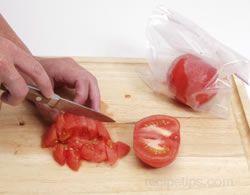 |
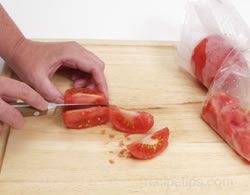 |
|
Tomatoes can be frozen whole, chopped or sliced. After removing the skin, cut the tomatoes into the desired size. Place tomatoes into a freezer bag, remove as much air from the bag as possible, seal and freeze. It is best to use the tomatoes within one year. Be sure to label and date your freezer bag.
Note: When freezing whole tomatoes, you can wait to remove the skins when they are thawed after freezing. Remove the stem core and freeze the tomatoes individually on a cookie sheet. Once they are frozen solid, place them in a sealable freezer bag. When ready to use, remove as many tomatoes as needed and run water over them. The skins should peel off easily. |
| Freezing Tomato Juice |
| What You Need:
- Blender
- 4 medium size raw tomatoes
- ½ medium onion
- 1 green pepper
- 1 to 1 ½ teaspoon salt, adjust to taste
- Optional: Fresh garlic cloves, to taste
- Optional: Oregano, to taste |
 |
|
Prepare fresh ingredients:
- Peel and core tomatoes as shown under Remove Tomato Skins.
- Remove stem, ribs and seeds from one green bell pepper and cut into strips.
- Cut one half of a medium onion into quarters.
- If garlic is to be added, remove the skin from the number of cloves desired.
|
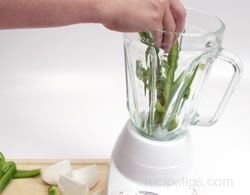 |
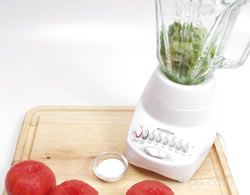 |
| Place green peppers and onions into blender and puree. |
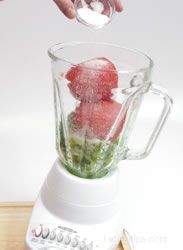 |
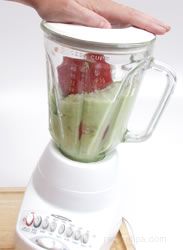 |
| Add tomatoes and salt to the peppers and onion. If desired, also add garlic cloves and oregano. Blend all ingredients until pureed. |
| When all ingredients have been pureed, the tomato sauce will appear pink in color. |
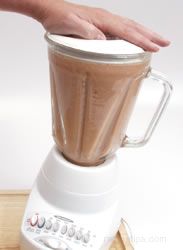 |
| To thicken and develop flavor, bring sauce to a slow boil, removing any excess water that appears on the top. |
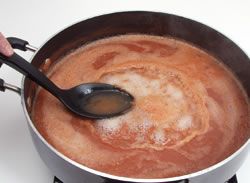
|
|
Simmer to desired consistency. As more liquid is boiled off, the tomato sauce will become more red in color. |
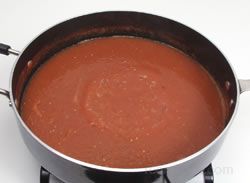 |
| Allow tomato sauce to cool and package in airtight freezer bag or container. When placed in an airtight freezer bag and frozen flat, pieces can be broken off and used as needed. It is best to use the tomatoes sauce within one year. Be sure to label and date your freezer bag. |
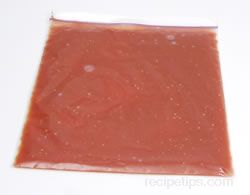 |
Tomato Cooking
Tomatoes can be broiled, roasted, stewed, sautéed, fried, and cooked in other food dishes. After cooking, tomatoes can be eaten on their own as a side dish or appetizer. They can also be added to sauces, soups, stews and other savory dishes. Some common cooking methods are shown below.
Broiled Tomatoes
- Core tomatoes, cut in half crosswise and place on a baking sheet in a single layer.
- Brush with melted butter and sprinkle with desired seasoning, such as salt, pepper, garlic and parsley.
- Place in the oven 4 to 6 inches away from the broiler heating unit.
- Cook for 3 to 5 minutes, until lightly browned.
Roasted Tomatoes
- Core tomatoes and cut in half lengthwise or crosswise.
- Place the tomatoes in a sealable plastic bag and add enough extra virgin olive oil to sufficiently coat them.
- Turn sealed bag until all tomatoes are well coated.
- Place tomatoes skin side down on a baking sheet. Arrange so there is a small amount of space between the tomato halves.
- Place in an oven preheated to 350°F and cook until tomatoes are bubbling and slightly browned, generally 45 to 60 minutes.
Stewed Tomatoes
- Peel skins from tomatoes, cut out the core and chop tomatoes into pieces. See Tomato Preparation.
- Place the prepared tomatoes in a saucepan.
- For approximately 2 pounds of tomatoes, add 1 tbsp. of butter, 2 tsp. of sugar, 1 tsp. of salt, and pepper to taste. If desired, other ingredients can be added, such as garlic, onion or green peppers.
- Cover and cook over low heat for 15 to 20 minutes, stirring every 4 to 5 minutes.
Sautéed Tomatoes
- Cut tomatoes crosswise into thick slices.
- Season with salt, pepper and desired herbs.
- Heat olive oil in a skillet over medium high heat.
- When oil is hot add tomato slices.
- Cook for 2 to 3 minutes or until tomatoes are just softened and lightly browned. Turn often and do not overcook.
Fried Tomatoes
Tips
- It is best to boil tomatoes with the skin, this will help retain the shape of the tomato.
- Avoid cooking in an aluminum pot, the tomato will develop an unpleasant metal taste which can also be harmful to the person consuming the tomato.
- When cooking tomatoes, adding a little sugar or honey will decrease the acidity of the tomatoes.
- To remove juices from cooked tomatoes, allow them to sit overnight in a bowl in the refrigerator. The juices will rise to the top and can then be spooned off.
Tomato Rose Garnish
|
Beginning at the top of a tomato, peel the tomato skin with a sharp utility knife. The garnish works best if the peel is ¾" to 1" wide, is a continuous peel, and the peel is thin with very little flesh attached. |
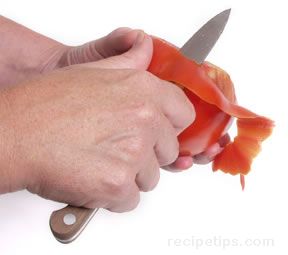 |
| Lie peel flat with flesh side up. Roll up the peel. |
 |
|
Set peel on plate and allow it to open. If needed, shape the peel to resemble an "opening rose". For finishing touch, add mint sprigs. |
 | |

